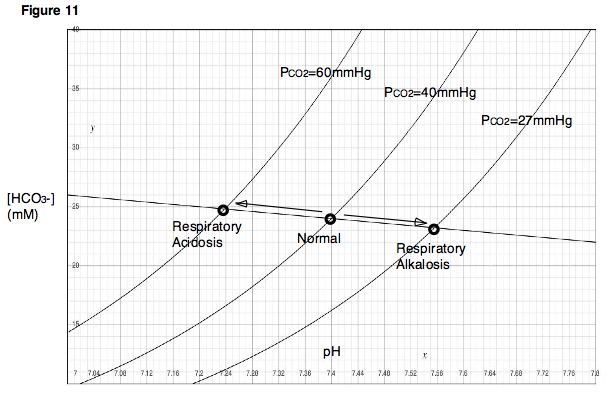Specialty endocrinology ICD-9-CM 276.3 MedlinePlus 000111 | ICD-10 E87.3 DiseasesDB 406 eMedicine med/2009 | |
 | ||
Respiratory alkalosis is a medical condition in which increased respiration elevates the blood pH beyond the normal range (7.35-7.45) with a concurrent reduction in arterial levels of carbon dioxide. This condition is one of the four basic categories of disruption of acid-base homeostasis.
Contents
Classification
There are two types of respiratory alkalosis: chronic and acute as a result of the 3-5 day delay in kidney compensation of the abnormality.
Terminology
Signs and symptoms
Signs and symptoms of respiratory alkalosis are as follows:
Causes
Respiratory alkalosis may be produced as a result of the following causes:
Mechanism
The mechanism of respiratory alkalosis generally occurs when some stimulus makes a person hyperventilate. The increased breathing produces increased alveolar respiration, expelling CO2 from the circulation. This alters the dynamic chemical equilibrium of carbon dioxide in the circulatory system. Circulating hydrogen ions and bicarbonate are shifted through the carbonic acid (H2CO3) intermediate to make more CO2 via the enzyme carbonic anhydrase according to the following reaction:
Diagnosis
The diagnosis of respiratory alkalosis is done via test that measure the oxygen and carbon dioxide levels (in the blood), chest x-ray and a pulmonary function test of the individual.
The Davenport diagram allows clinicians or investigators to outline blood bicarbonate concentrations (and blood pH) after a respiratory or metabolic acid-base disturbance
Treatment
Respiratory alkalosis is very rarely life-threatening, though pH level should not be 7.5 or greater. The aim in treatment is to detect the underlying cause. When PaCO2 is adjusted rapidly in individuals with chronic respiratory alkalosis, metabolic acidosis may occur. If the individual is on a mechanical ventilator then preventing hyperventilation is done via monitoring ABG levels.
Society
In The Andromeda Strain, one of the characters is exposed to contamination, but saves himself by increasing his breathing rhythm until he has respiratory alkalosis in his blood.
